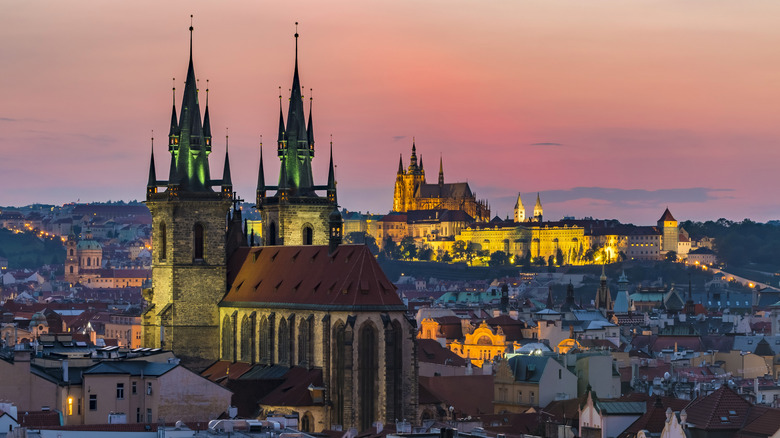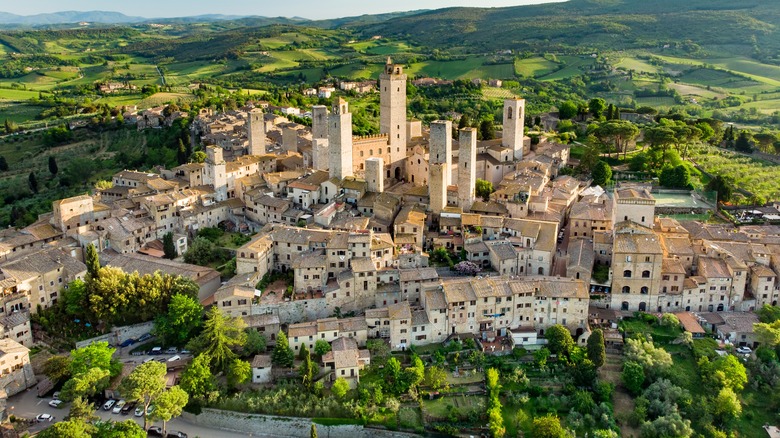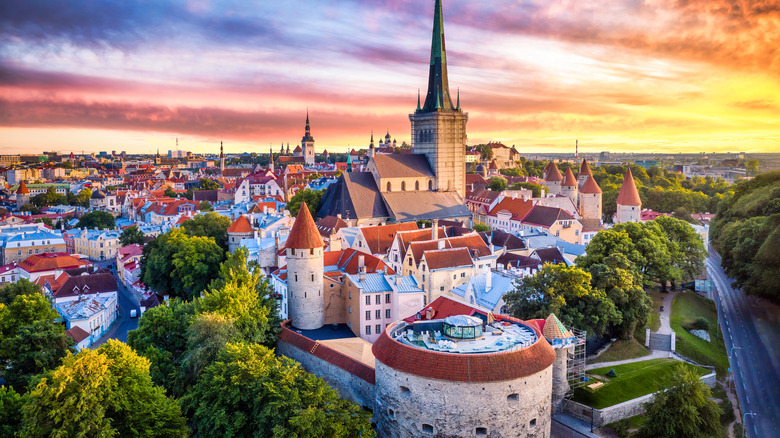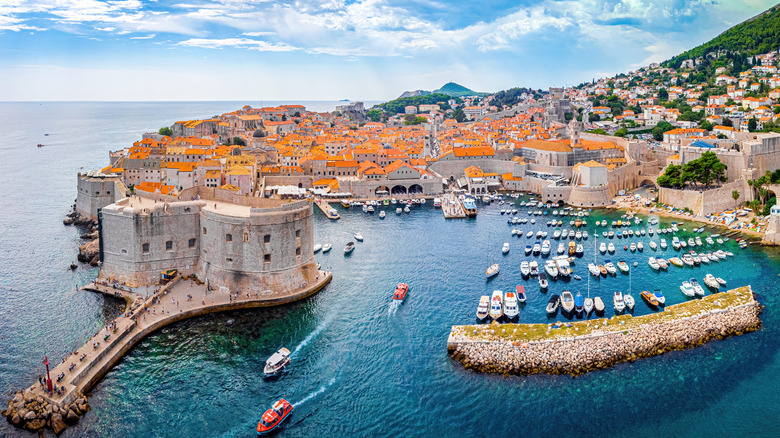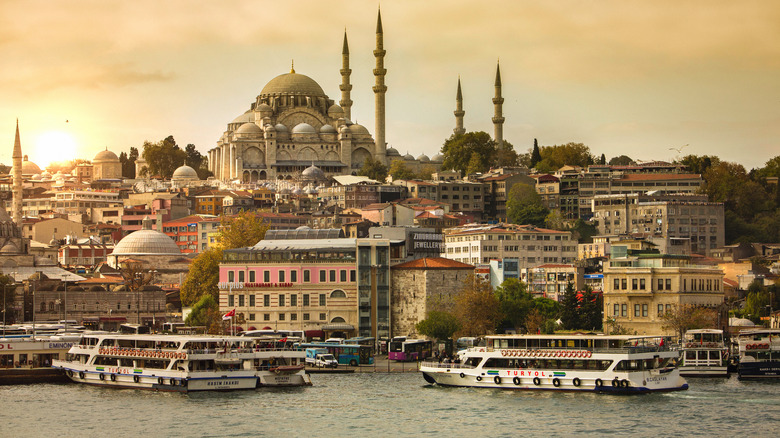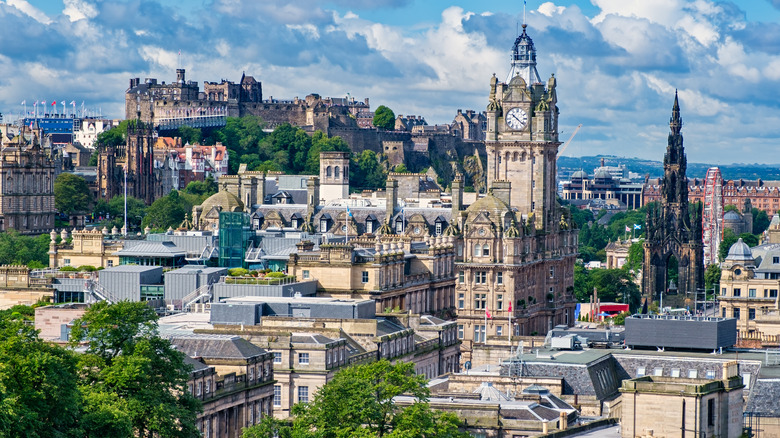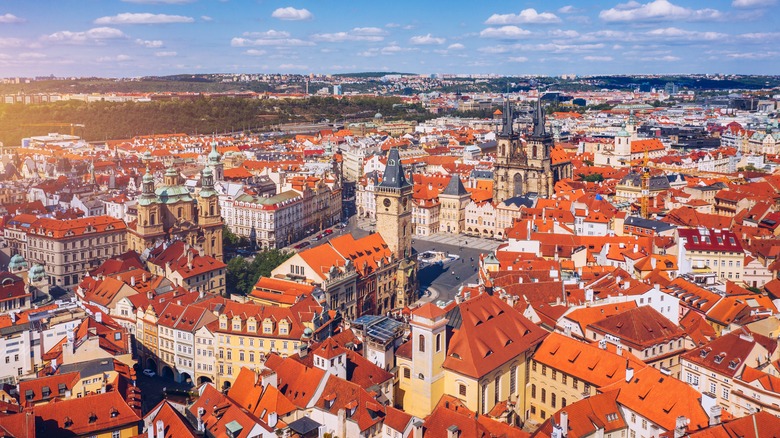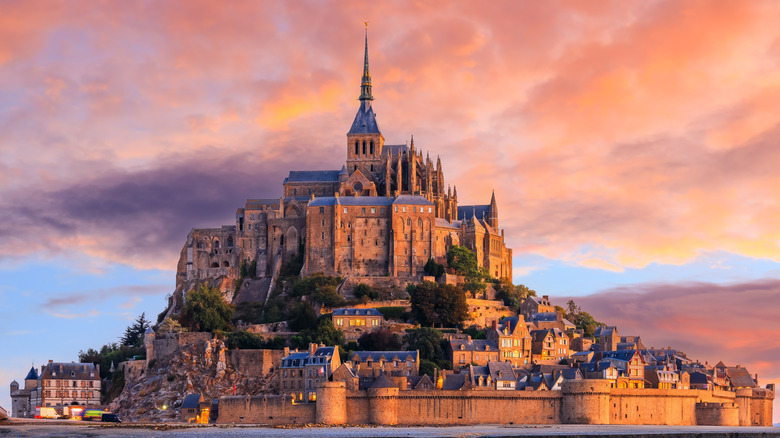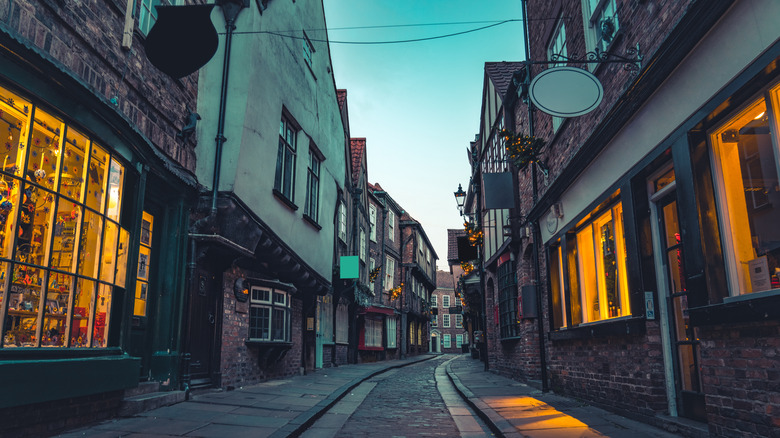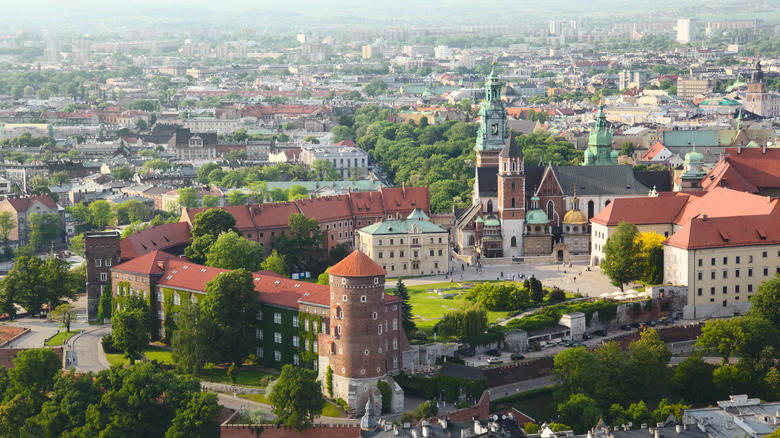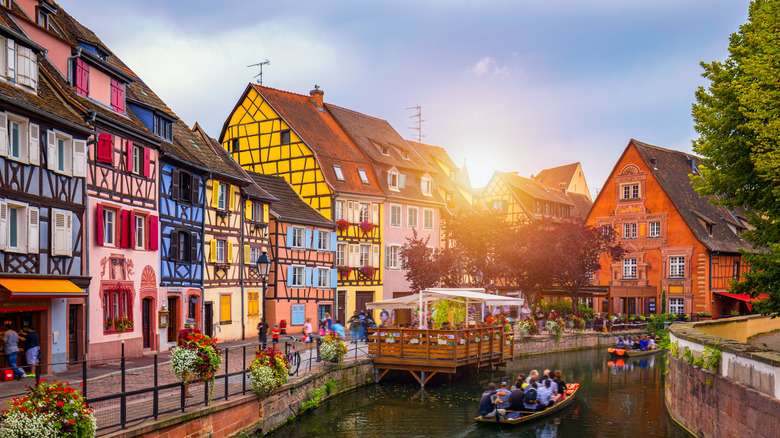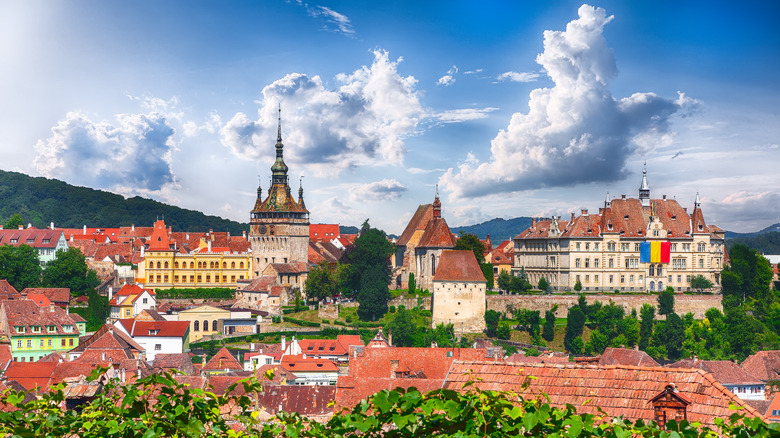Medieval Towns You Don't Want To Skip When Visiting Europe
The United States — and New World as a whole — didn't have a Middle Ages. Although the Declaration of Independence was signed by the U.S. nearly 250 years ago, that is basically yesterday on Europe's timeline of recorded history. In contrast, plenty of European cities can trace their history back to the Middle Ages, which is usually categorized as between A.D. 500 to 1300. And, luckily for curious European travelers, some of those cities look nearly as they did 1,000 years ago.
If you want to see Gothic church spires, original market squares, and intimidating stone walls that once defined the medieval period — as well as a few nods to Harry Potter and Count Dracula — then these are the medieval cities that you have to see to believe. Most of these cities are UNESCO World Heritage Sites, meaning they're protected landmarks that will hopefully be here to enjoy in another 1,000 years.
San Gimignano, Italy
It's easy to spot San Gimignano as you wander up from the green, rolling hills and vineyards of Tuscany. The Italian town's 13 remaining looming towers are the highest peaks in miles, but they once served a more practical purpose during the Middle Ages: the higher the tower, the more prestige and money of the family who owned it. Some of the standout towers you can still see today are Torre Grossa and Torre Rognosa. Surrounding the towers are original ramparts that once protected the popular tourist destination, as well as winding, cobblestone streets, colossal churches, and stone squares — especially Piazza della Cisterna and Piazza del Duomo — which remain the epicenters of town activity.
However, it was due to unfortunate circumstances that San Gimignano, which dates back to 1199, is so well-preserved. It lost countless citizens due to famine and the bubonic plague after the mid-1300s. After, government officials did not consider the town for urban renewal. Today, it retains much of its original charm, and it's only an hour's drive from Florence. While here, wander the town's quaint shops and restaurants, and don't leave without sampling Vernaccia di San Gimignano, a white wine that can only be found in the area. The same wine was enjoyed by the Italian elite in the 13th century.
Tallinn, Estonia
Tallinn rarely gets the tourist recognition that medieval cities like Prague, San Gimignano, and Istanbul receive, but it certainly deserves it. The middle of this 13th-century city, which is called Tallinn Old Town, very much resembles what it looked like more than 800 years ago. And, making it the best of both worlds for both travelers and visitors, Old Town is surrounded by modern buildings, restaurants, attractions, and amenities.
Despite now being an Estonian city, Tallinn has undergone many owner — and even name — changes throughout the centuries. Over the years, Tallinn has been known as Reval and governed by both the Swedish Empire and Russian Empire. With such a rich history, all of Old Town is a UNESCO World Heritage Site that includes spots like St. Mary's Cathedral, Tallinn Town Hall (one of the oldest on the continent), and Toompea Castle. You can see many landmarks by walking Tallinn's ramparts, some of which are open to visitors and cost only a few euros to enter. On the ramparts, you'll also run into many museums and art galleries, which once served as jails and shops.
Dubrovnik, Croatia
After the tragedy of the Serbia-Croatian War 30 years ago, Dubrovnik — surrounded by picturesque blue waters, amazing seaside mountains, and secret sea coves — has evolved into an incredibly popular destination. This is partly due to "Game of Thrones" fans flocking to Dubrovnik, which served as a primary setting for the popular TV series. The medieval city, all of which is a UNESCO World Heritage Site, is full of buildings with red terracotta roofs and homes dating back centuries. Dubrovnik also boasts plenty of modern shops, restaurants, and upscale hotels for vacationers.
Tracing its history to the seventh century, Dubrovnik is full of historic architecture, and the center of Old Town is free of any cars. Get a lay of the land by first walking on the 80-foot-high stone walls that once protected the city. Then, head to Rector's Palace, the 15th-century structure with a unique blend of Gothic, Baroque, and Renaissance architectural styles. Visitors can see historic items and rooms of the rector's former home. Afterward, check out Dubrovnik Cathedral, which dates to the 17th century and is known for its collection of gold and silver relics. Dubrovnik is also full of happening squares, and the medieval town is perfect for wandering to find the perfect restaurant, bar, or spot to people-watch.
Istanbul, Turkey
Istanbul dates back to 667 B.C., making it perhaps the oldest city on this list, and maybe the most unique, too. Thanks to its position in both Asia and Europe, Istanbul is the only major city on the planet to span two continents. Over the years, the city's been known as Byzantium, Constantinople, and Istanbul. It's also been the capital of two empires, and the number of mosques, churches, and Instanbul's diverse architecture all reflect these changes and cultural influences.
As one of the largest cities in both Europe and Asia, there is a never-ending well of things to do in Istanbul, ranging from visiting the Hagia Sophia Mosque with its domed towers, sprawling ceilings, and bright interior, to wandering the endless aisles of the Grand Bazaar, home to over 3,000 vendors under a covered market.
If you're a fan of the Grand Bazaar, then make sure to also visit the Spice Bazaar, which dates back to the 17th century, to sample a wide array of Turkish snacks. Visitors should also visit the Blue Mosque, which is one of the most popular sites in Istanbul. This mosque, constructed in the 1600s by Sultan Ahmed I, was built and designed to outshine the Hagia Sophia.
Edinburgh, Scotland
With a castle towering above, historic Gothic churches, and a raincloud that seems to hover over the city in perpetuity, Edinburgh seems to define a medieval city in appearance. Edinburgh Castle, a must-see site and museum, houses priceless historic items and dates back to the 12th century. If you want to see more items that showcase Scotland's history, visit the free National Museum of Scotland, which boasts over 20,000 items in its collection — both experiences are perfect rainy-day activities.
To get a better view of the city, climb Arthur's Seat, a volcano that offers great vantage points. You can also get picturesque, panoramic views of Edinburgh's skyline by climbing Calton Hill. The National Monument on top of the hill is modeled after the Parthenon and is a UNESCO World Heritage Site.
But if haunted history is more your thing, then no visit to Edinburgh is complete without an Edinburgh Dungeon tour, where you'll learn about the city's darker past. Finally, catch a breath -– and a sip — at the Scotch Whisky Experience, where you can learn about how Scotch is made before grabbing pub fare at one of the city's many restaurants. If you're an adventurous eater, then try the famed haggis, which is seasoned sheep innards boiled inside the sheep's stomach.
Prague, Czech Republic
When travelers think of medieval cities, perhaps none come to mind quicker than Prague, which is filled with storybook-like architecture and everything from a castle to an astronomical clock — all topped off with some of the best beer in Europe. However, this beautiful city has endured a lot since its founding around A.D. 870 –- from catastrophic floods to takeovers by numerous empires — to get it to where it is today.
One of the best ways to get a feel for the medieval history of Prague is to start your visit at the Old Town Square, which is full of red-roofed buildings that look much as they did when the square was the city's market. Here, you can enjoy a classic Czech meal like beef goulash or roast pork and cabbage while checking out the colorful Prague Astronomical Clock, which has used symbols to share the current moon phase since it was erected in the 15th century.
Another popular attraction in Prague is the circa-1357 Charles Bridge, home to 30 statues depicting saints that lead tourists to Lesser Town, another part of the city. But don't leave Prague without checking out Prague Castle, where the Czech president works. The UNESCO World Heritage Site is one of the largest castles in the world.
Mont-Saint-Michel, France
You might not know one thing about Mont-Saint-Michel — such as it's thought to be haunted or that it's surrounded by quicksand — but you've probably seen images of the island. Renowned for its towering castle, the island has inspired the design of kingdoms in movies like the "Lord of the Rings" and "Tangled," and is perhaps one of the most iconic images in Europe.
According to legend, Mont-Saint-Michel was founded in the eighth century when a bishop from a nearby village claimed that Archangel Michael told him to build a castle in that exact spot. It supposedly took three asks from the archangel, but finally, construction started, although it took centuries to complete. The castle is within a bay that is a territory of both Normandy and Brittany.
The tides of the bay are a sight all their own, ranging as much as 50 feet. But don't get too close to the tides, as they can be very dangerous without a guide. The bay is so dangerous, in fact, that the island itself held around 14,000 prisoners of Napoleon until eventually closing in 1863. Today, along with the castle, you'll also find boutique shops, eateries, and resorts on the island.
York, England
Many tourists heading to England only explore London, but when they do, they're missing out on a country full of medieval history –- especially in York, which is a two-hour train ride from the capital of England. York is surrounded by its famed City Walls. Although the wall traces its earliest construction to Ancient Roman times, a substantial majority of the City Wall was built during the Middle Ages. Today, they're the longest medieval town walls in England.
York is truly a medieval wonderland. It's even home to one of the continent's most well-kept streets from the Middle Ages — Shambles, which is full of buildings constructed of half-timbers that date back to the 1200s. Harry Potter fans may also likely notice that Shambles looks a lot like Diagon Alley, and they're right. J.K. Rowling was supposedly inspired by Shambles to create Diagon Alley. On this real-life street, visitors can unsurprisingly find plenty of Harry Potter-inspired shops and restaurants.
Near Shambles is York Minster, a seventh-century church with Gothic architecture known as one of the planet's most beautiful. However, there's plenty of dark history in York, too. It's been called one of the most haunted towns in Europe. If you want to learn it all, hop on a walking tour to meet all of the local ghosts, or visit the York Dungeon, an educational yet thrilling way to learn York's real-life spooky stories.
Krakow, Poland
If you're one of the millions of people who visit Krakow annually, you'll be walking where kings and queens once walked –- no matter where you go. That's because the entire city was once their home, and today, visitors can see that history through many of Krakow's medieval buildings like the Wawel, where coronations were once held, and the Royal Castle, which dates back to the 16th century. However, there are plenty of attractions for us common folk, too.
The 10-acre Main Market Square is the continent's biggest remaining market square from the Middle Ages, and it's home to sites like the Town Hall Tower and St. Mary's Church. If you want to see the best of what Krakow has to offer, then the Main Market Square is a great spot to start. The museums in the area are home to a whopping quarter of the entire country's historic items. Although Krakow has kept its original medieval layout, the city's stone walls are long gone. Instead, the city is surrounded by the Planty, a lush park that's perfect for taking a break from the crowds.
Colmar, France
Filled with canals stocked with gondoliers shuffling people to their next destination, half-timber homes that look summoned from "Beauty and the Beast," and colorful florals on every corner, Colmar looks a lot more like a traveler's dream than a real city. However, this medieval city bordering France and Germany is the real deal, and it's the perfect place to visit during the holiday season. Due to its abundance of festive Christmas lights and décor, Colmar is one of Europe's most magical Christmas towns.
With its many waterways, Colmar is known as the "little Venice of France," and if you hop on a gondola, you'll pass the spots where medieval fishmongers and winemakers once worked their magic. After a gondola tour, head to Champ de Mars, a public park that has statues of Colmar's most famous residents. One of those people was Auguste Bartholdi, a French sculptor who created the Statue of Liberty. A museum dedicated to Bartholdi sits in the middle of town and showcases the sculptor's life and early works.
Sighisoara, Romania
Located within Transylvania, Sighisoara, which has held several names since it was founded in the 16th century, is where Vlad the Impaler, otherwise known as Vlad Tepes, once called home. Tepes, who inspired Count Dracula, was born and lived here with his father for several years, and his house, with an imposing dragon statue out front, can still be seen in Citadel Square. However, there's much more to explore in the scenic city. Sighisoara, a UNESCO World Heritage Site, is one of the most authentic towns from the Middle Ages still standing in Europe, and it has plenty of other medieval spots to check out.
Sighisoara is home to nine towers that date back to the 16th century. Some of those include the Blacksmiths' Tower, Butchers' Tower, and the ever-popular Clock Tower, which is one of the city's most-visited sites. To get a good view of the towers and skyline of the city, visit the city's popular History Museum, which served as an administration building for the town council until 1556.
